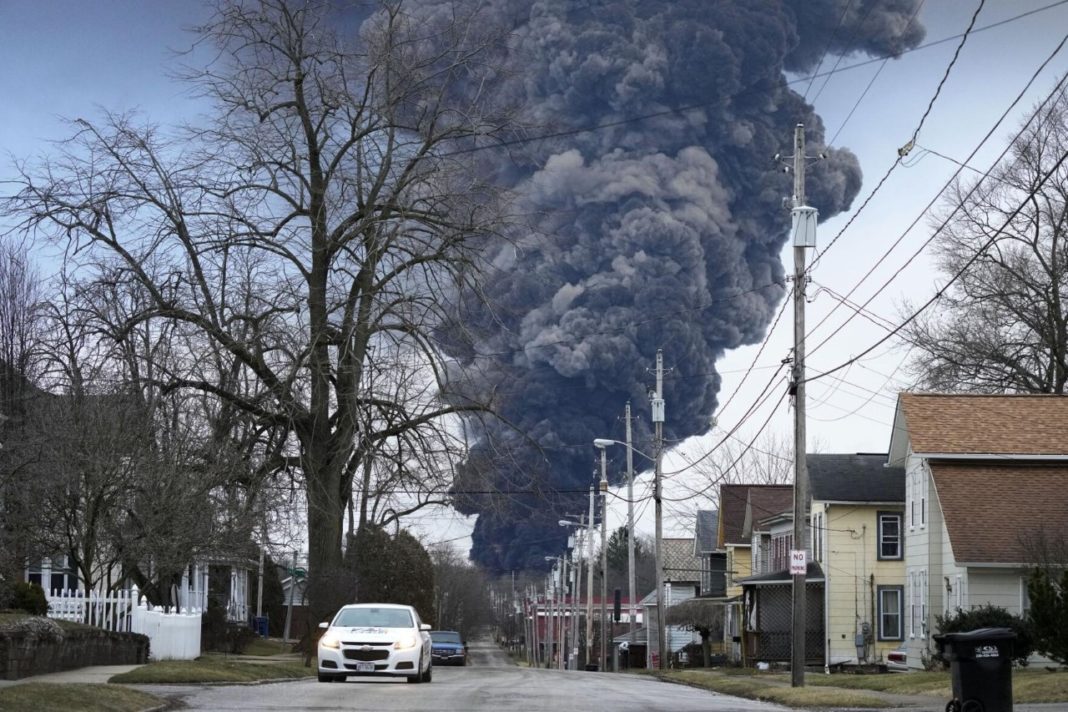
Photo courtesy of Gene J. Puskar / Associated Press
Slippery Rock is listed as part of a class-action lawsuit against Norfolk Southern Railway Company after the Feb. 3 derailment in East Palestine, Ohio resulted in a fire and release of vinyl chloride and other toxic chemicals.
Vinyl chloride—an extremely flammable, potentially explosive chemical—can irritate the eyes, mucous membranes and respiratory tract, according to the Centers for Disease Control and Prevention (CDC). The CDC said chronic exposure to the chemical could cause permanent liver injury and cancer, neurologic or behavioral symptoms and changes in the skin and bones of the hands.
Residents of the area are experiencing symptoms like coughing and chest pain, among others. Some areas of Butler County, including Slippery Rock, are about 30 miles from the site.
The lawsuit is one of at least six class-action lawsuits filed against Norfolk Southern. Those involved in the cases allege a loss of income due to evacuations, as well as exposure to cancer-causing chemicals, NBC News said in an article Saturday.
Filed in the U.S. District Court for the Northern District of Ohio, Andrew Erdos and David Anderson said they are seeking funding for medical monitoring of residents within a 30-mile radius of the derailment.
It has been about 20 days since the controlled burn that released toxic chemicals into the atmosphere. Norfolk Southern CEO Alan Shaw stands behind the decision, according to a statement to WFMJ of Youngstown, Ohio.
The company hired consultants to test the air and water quality in conjunction with the U.S. Environmental Protection Agency (EPA). According to Shaw, all air and municipal water tests came back clean.
Pennsylvania’s response and timeline
On Feb. 28, Pennsylvania Governor Josh Shapiro announced the Pennsylvania Department of Health (DOH) is opening a health resource center in Darlington Township, Beaver County, after the Norfolk Southern derailment.
The center is for residents of Beaver and Lawrence Counties who have health concerns following the East Palestine train derailment.
The Pennsylvania DOH will provide webinar sessions to physicians in Beaver, Lawrence and surrounding areas to brief them on the derailment, the chemicals involved and what signs and symptoms to watch.
The Environmental Protection Agency (EPA) also opened a community welcome center at 25 N Market St. in the evacuation zone for people to direct questions and access information.
Norfolk Southern also announced the establishment of a family assistance center to support the community.
These welcome centers were introduced after a Norfolk Southern freight train derailed in East Palestine, Ohio on Feb. 3, releasing hazardous chemicals into the air, land and water.
General merchandise train 32N derailed first, causing 38 additional cars to derail and a fire that damaged 12 more cars. Of the 20 total cars with hazardous material, 11 derailed. NTBS previously said it was 10 cars that derailed containing hazardous material.
The most alarming toxic chemicals include vinyl chloride, butyl acrylate and ethylhexyl acrylate.
“When they burned the vinyl chloride, that scared the ‘bejesus’ out of people,” Michael Stapleton, an SRU environmental chemistry professor, said.
Stapleton used to be an environmental consultant and has visited many sites like East Palestine. He previously conducted human health risk assessments for hazardous waste in trash and steam incinerators.
Vinyl chloride is a monomer. When it binds into a polymer, it creates polyvinyl chloride, which is used in hard plastics like PVC pipes, wire, cable and packaging materials.
Vinyl chloride exposure is associated with an increased risk of a rare form of liver cancer called hepatic angiosarcoma, primary liver cancer, brain and lung cancers, lymphoma and leukemia.
Butyl acrylate is a colorless liquid with a strong, fruity odor. Exposure can irritate the eyes, skin and upper respiratory system.
Ethylhexyl acrylate is a colorless liquid with a pleasant odor that’s used in making paints and plastics. Inhalation and ingestion can cause drowsiness and convulsions, and liquid exposure can cause eye irritation or skin irritation if prolonged.
Other potentially harmful chemicals found include ethylene glycol mono butyl ether, isobutylene, hydrogen chloride, combustible liquids and benzene residue.
An engineer, a conductor and a conductor trainee were onboard the train. None of them were injured, and no other injuries or fatalities have been reported.
The train consisted of two head-end locomotives, 149 railcars and one distributed power locomotive between railcars 109 and 110. Each rail car is about 50 feet, so the train is about 1.5 miles in total. Nine of the train cars were empty.
The National Transportation Safety Board (NTSB) is leading the investigation into the cause of the derailment and has identified and examined the rail car.
Moments before the derailment, surveillance video from a nearby residence showed what appeared to be a wheel bearing overheating.
Interestingly, the train car was going below the maximum authorized speed of 50 mph when it derailed.
Another security camera video at an equipment plant in Salem, Ohio, 20 miles away from East Palestine, shows what appears to be sparks and flames coming from the bottom of the train cars.
“The crew did receive an alarm from a wayside detector shortly before the derailment indicating a mechanical issue,” Michael Graham, an NTSB member, said to CBS News. “Then, an emergency brake application initiated.”
The train departed Madison, Wisconsin on Feb. 1 and likely passed through Toledo and Cleveland before reaching Salem where the first video was taken.
Norfolk Southern uses hot-bearing detector systems (HBD) to monitor wheel-bearing temperatures and audibly alert the crew. The train passed three HBD systems before derailing.
The first system recorded a temperature of 38 degrees above normal from a bearing on the 23rd car. The second was recorded at 103 degrees above normal, and the third was 253 degrees above normal.
A warm bearing is classified as being between 170 and 200 degrees and requires a stop for inspection. If the temperature rises above 200 degrees, it is considered critical.
The system notified the crew of a hot axle, so they stopped and notified the Cleveland East dispatcher of a possible derailment after seeing smoke and fire.
With dispatcher authorization, the crew uncoupled the head locomotives and moved them about one mile away.
The EPA had personnel on site by 2 a.m. and have been spearheading the air quality testing. Ohio, local health agencies and local public water systems have been leading the water sampling process.
The EPA uses two types of air quality testing: air sampling and air monitoring. Sampling involves collecting samples over time that are sent to a lab for analysis. Monitoring uses electronic devices to provide real-time readings of airborne contaminants.
They set up testing stations near schools, government buildings, residential areas and upwind and downwind of the derailment site.
A day after the derailment, locals noticed water spillage into Sulfur Run and Leslie Run. Booms and underflow dams were installed to separate floating pollutants. Sulfur Run flows into the Ohio River, but Stapleton said the contaminants should be mostly diluted when they get there.
The EPA collected surface water samples and soil and sediment samples testing for volatile organic compounds and others. The sample locations were based on how water flows from the derailment site to nearby streams.
On Feb. 5, five derailed cars containing 115,580 gallons of vinyl chloride concerned authorities when the pressure in one tank was still rising. The pressure increase suggested the chemical was undergoing a reaction and could explode.
Ruth Householder, 90, lives directly across from the wreck and about two blocks over.
“Boy, that fire was so high. It was frightening,” she said.
Householder received a phone call that night telling her to leave immediately due to an expected explosion. She called her son who lives next door, and they fled to her daughter’s house.
On Feb. 6, Ohio Governor Mike DeWine and PA Governor Shapiro expanded the evacuation order from a one-mile area to a one-by-two-mile area. They also dug ditches to contain liquid vinyl chloride while it was vaporized and burned.
Authorities used small-shaped charges to breach the tank cars before venting them at around 4:40 p.m.
Smoke inhalation presented dangers to both authorities and locals during this time. The symptoms residents reported could have been due to thermal injury to the upper airway, chemical injury to the upper and lower respiratory tract or other systemic effects from toxic gasses.
On Feb. 9, the EPA lifted the evacuation and reported that the air had returned to normal.
Since then, the EPA has conducted 578 home re-entry screenings and continues air monitoring at 15 stations around the East Palestine community.
Norfolk Southern’s waste disposal and cleanup have been closely monitored by the EPA.
Norfolk Southern CEO Alan Shaw visited East Palestine on Feb. 18 to support the community but was not exactly received with open arms. The company had previously failed to send representatives to a town hall on Feb. 15 citing a “growing physical threat.”
“There’s nothing worse than going into a meeting with 800 people that are pissed off,” Stapleton said.
Stapleton visited the site on Feb. 24 to take pictures and observe cleanup efforts. He noticed three or four street sweepers active, which he thought was bizarre.
He saw several vacuum trucks at the scene and thought they could have been used to clean up runoff from the initial fires. He also saw signs that trains had been through since.
“They rebuilt probably a half-mile of track in a couple [of] days,” he said.
Lighter limestone indicated that the track had been reset recently.
About 500,000 gallons of contaminated dirt and water were sent to a treatment facility in Deer Park, Texas, according to Harris County Judge Lina Hidalgo.
Vickery Deepwell Hazardous Waste received 581,500 gallons of contaminated water, and Republic Waste Services near Detroit also received waste.
Deepwell injection is a waste disposal method where liquid waste is poured into deep wells far below the water table where there is no potential for contaminants to spread.
“The amount of money that’s been spent is pretty unbelievable,” Stapleton said.
On Feb. 27, Secretary of Transportation Pete Buttigieg wrote to CEOs of class one freight railroads encouraging them to join the close calls reporting system. The system prevents safety issues and protects workers who report safety violations. No freight rail companies have signed up at the time of publishing.
Effects on Slippery Rock
Slippery Rock, Pennsylvania is just 30 miles from East Palestine. The drive is less than an hour. Being so close to the area sparks some concerns.
One of those has to do with the water quality in Slippery Rock, with residents questioning if it was contaminated.
The Slippery Rock Borough attempted to ease these growing fears. The Slippery Rock Municipal Authority (SRMA) put out a statement on Feb. 21 to let residents know they are continuing to monitor water.
“We continue to diligently monitor our water supply for abnormalities as well as to ensure compliance with all PA DEP requirements and regulations,” the SRMA statement said. “The SRMWA water samples show no quality concerns.”
Slippery Rock Mayor Jondavid Longo has worked closely with the SRMA, but he made it clear that they are separate from the borough, and he doesn’t have any control over SRMA. He consistently works to make sure communication runs smoothly.
“I did spend hours with the managers and the board members of the plant talking over the concerns that some people might have about our water, and they’ve assured me that none of their tests have shown any irregularities, nor have they gotten any direction from Pennsylvania or the federal government to do anything they aren’t already doing,” Longo said. “They are very confident that our water system is safe and secure.”
Longo said he understands why people are starting to pay attention to what happened and asking questions. He has also been following the developments of the situation.
“I think that everyone in the region has a right to feel concerned about this awful event that has occurred, naturally a giant, black gloom of smoke traveling miles into the stratosphere being pushed over municipalities like Slippery Rock is surely a concern to those of us worried respiratory health,” Longo said.
SRU also sent out an email that reaffirmed what the SRMWA released in their statement.
As far as water quality is concerned, Langdon Smith, SRU environmental science professor, explained Slippery Rock residents are fortunate to be located where they are in proximity to East Palestine.
“We’re very fortunate that it’s all running down and away from Pennsylvania, lucky water runs downhill, and these drainages are taking that away,” Smith said. “There could be in areas right around East Palestine, from air emissions and it could’ve settled down and got into groundwater, but Pennsylvania has set up some water testing.”
Slippery Rock is far enough away that it’s highly unlikely that air emissions will affect the community, but Smith explained when it comes to water it changes very slowly.
“Groundwater movement is really slow, so it’ll take a long time for people to figure out what the damage is,” Smith said. “They’ve started to drill monitor wells around the site, and I would guess that will continue for years.”
People are also wondering if the rain in the area is contaminated, but Smith explained that if weather conditions were different, then Slippery Rock may have been affected more.
“It could’ve been bad in Slippery Rock if we had wind and storms carrying it over us, but that wasn’t the case,” Smith said. “If we had typical weather, then it could have carried the contaminants over us.”
The situation has drawn attention from all over the country, but especially from people in Western PA and Eastern Ohio. But to Smith, it’s not only a wake-up call for people to start paying attention to the environment but also the things that the government is doing that have effects on the environment.
“[Students] need to start paying attention to what their communities are doing, for example, there are a few West Virginia communities involved, and by the time it gets there it may be diluted enough to not have an effect,” Smith said. “I think the important thing for people to do is to pay attention, watch the news and listen to what the reports are so that they’re educated about the risks.”








